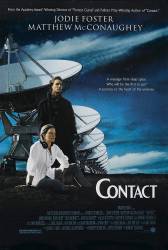Visible crew/equipment: As Ellie runs up the stairs of the observatory after hearing the first audio transmission from space, she runs towards doors with two large glass windows in them. As she opens the doors, a crewman/cameraman is visible in the right window for a brief fraction of a second.
Visible crew/equipment: During the scene when Ellie has discovered the Signal, and is in the control room with the guys, she turns to one of them and says "Make me a liar". Right when she turns, you can see some bright, smaller, roundish white lights reflected in her eyeglass lens. These are probably camera lights, as their appearance wouldn't match the computer screens or natural lighting in the room.






Answer: If anything, I think the film's producers deliberately left godly topics unaddressed (and questions dangling, unanswered) because they didn't want to alienate any particular audience. However, we know the producers of "Contact" certainly did vilify religion through the sinister scenes with Joseph, the evangelical extremist. At the same time, the film created empathy for the president's glib theological adviser, Palmer Joss. So, I don't think the film was shying away from religious topics, and I think it was pretty fair to the religious viewpoint, for the most part. But this movie wasn't about religion; it was about a primitive, materialistic, self-centered and aggressive species (humanity) reluctantly acknowledging the existence of vastly more intelligent and even godlike entities throughout the cosmos. Even the first-contact entities, advanced as they are, acknowledge other entities much more ancient and much more advanced (the virtual architects of the space/time conduit). The implication was that we live in a universe that may be populated with many intelligent entities that answer every human criteria of godhood. Ellie's narrow-minded atheism was surely shaken to its foundation by her experience; and, while she didn't "convert" to archaic earthly religions, she was spiritually a different person upon her return. The film, however, is open-ended and fence-straddling and doesn't presume to definitively answer the question of the existence of god, leaving it up to the audience to decide.
Charles Austin Miller